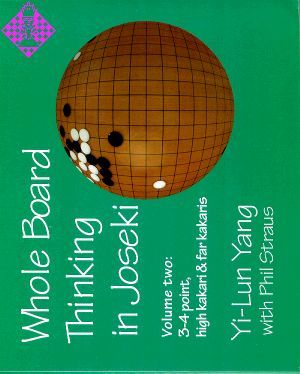Artikelnummer
LGYANWBTIJ2
Autor
Whole Board Thinking in Joseki, Vol. 2
3-4 point, high kakari & far kakaris
181 Seiten, kartoniert, Fourth Line Press, 1997
Final vergriffen
With tens of thousands of patterns to choose from, the study of joseki might seem daunting. Not so! Mr. Yang's simple but powerful principles for globaly consistent opening play will tree you from rote memorization.
I his is the second in a series of Whole Board Thinking books. It is the first time that go theory of this caliber has appeared in the West before it was available in Asia.
Don t miss your chance to leap ahead instead oi struggling just to keep up.
I his is the second in a series of Whole Board Thinking books. It is the first time that go theory of this caliber has appeared in the West before it was available in Asia.
Don t miss your chance to leap ahead instead oi struggling just to keep up.
With tens of thousands of patterns to choose from, the study of joseki might seem daunting. Not so! Mr. Yang's simple but powerful principles for globaly consistent opening play will tree you from rote memorization.
I his is the second in a series of Whole Board Thinking books. It is the first time that go theory of this caliber has appeared in the West before it was available in Asia.
Don t miss your chance to leap ahead instead oi struggling just to keep up.
I his is the second in a series of Whole Board Thinking books. It is the first time that go theory of this caliber has appeared in the West before it was available in Asia.
Don t miss your chance to leap ahead instead oi struggling just to keep up.
| EAN | 096535461X |
|---|---|
| Gewicht | 462 g |
| Hersteller | Fourth Line Press |
| Breite | 15,1 cm |
| Höhe | 18,9 cm |
| Medium | Buch |
| Erscheinungsjahr | 1997 |
| Autor | YiLun YangPhil Straus |
| Sprache | Englisch |
| ISBN-10 | 096535461X |
| Seiten | 181 |
| Einband | kartoniert |
vii Preface
003 INITIAL CHOICE
012 LOW ATTACHMENT
046 HIGH ATTACHMENT
068 ONE-SPACE LOW PINCER
101 TWO-SPACE HIGH PINCER
136 THREE-SPACE PINCER
143 LOW FAR KAKARI
157 HIGH FAR KAKARI
180 Glossary of Terms
181 About the Authors
003 INITIAL CHOICE
012 LOW ATTACHMENT
046 HIGH ATTACHMENT
068 ONE-SPACE LOW PINCER
101 TWO-SPACE HIGH PINCER
136 THREE-SPACE PINCER
143 LOW FAR KAKARI
157 HIGH FAR KAKARI
180 Glossary of Terms
181 About the Authors
The ancient proverb hasn't changed ...
...since we published volume one. So why yet another book on joseki?
Because the first book only covered the low kakaris?
Well, that's true, but there is a larger reason. This series is a set of books about large-scale go thinking disguised as joseki books. If you learn the concepts in this book, you will get a glimpse of how a professional mind envelopes the board.
The first glimpse is into the difference between volumes I and II of Whole Board Thinking in Joseki. What is the difference between the low kakari and the high kakari?
The low kakari (Vol. I) is best for territory and defense later in the game. The high kakari (this book) is best for outside positions and for attacks later in the game. This book also covers the low and high two-space kakaris. In general, the low far kakari destroys the side and the high far kakari controls the side.
In this book, we teach the meaning of specific josekis by showing fusekis for which each joseki is perfect. In josekis, some moves are dictated by the local situation, while others have more global considerations. The problems address the global issues by presenting at least two fusekis for each joseki choice. Each problem shows a full-board situation in which one of the choices is ideal. You will learn the joseki by first learning the purposes of the different variations. You will find that understanding makes memorizing easier.
...since we published volume one. So why yet another book on joseki?
Because the first book only covered the low kakaris?
Well, that's true, but there is a larger reason. This series is a set of books about large-scale go thinking disguised as joseki books. If you learn the concepts in this book, you will get a glimpse of how a professional mind envelopes the board.
The first glimpse is into the difference between volumes I and II of Whole Board Thinking in Joseki. What is the difference between the low kakari and the high kakari?
The low kakari (Vol. I) is best for territory and defense later in the game. The high kakari (this book) is best for outside positions and for attacks later in the game. This book also covers the low and high two-space kakaris. In general, the low far kakari destroys the side and the high far kakari controls the side.
In this book, we teach the meaning of specific josekis by showing fusekis for which each joseki is perfect. In josekis, some moves are dictated by the local situation, while others have more global considerations. The problems address the global issues by presenting at least two fusekis for each joseki choice. Each problem shows a full-board situation in which one of the choices is ideal. You will learn the joseki by first learning the purposes of the different variations. You will find that understanding makes memorizing easier.

